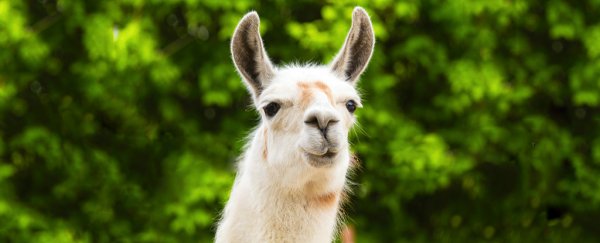A long-lasting vaccine that protects people from seasonal influenza infections could finally be on its way, following the production of a new kind of antibody based on a variety found in llamas, camels, and other related animals.
The antibodies have successfully protected mice from influenza A and B, both when injected directly and when delivered by a specially engineered virus.
If future clinical testing proves just as fruitful, this just might give us the edge we need over the deadly influenza pathogen that kills tens of thousands each year.
An international research team has engineered a kind of pocket-sized Swiss army knife of antibodies that locks onto a range of markers unique to influenza viruses.
They did so with the help of an unusual class of antibodies produced by camelids – animals we'd identify as camels, alpacas, and llamas.
"This is a great story and shows the power of antibody engineering," immunologist Antonio Lanzavecchia from the Institute for Research in Biomedicine in Switzerland told Science Magazine.
The two main types of responsible influenza in humans – simply called A and B – include a mixed bag of strains, which evolve frequently thanks to the pathogen's highly fragmented genome.
Influenza's jumble of genes helps it constantly change out a type of biomarker - called hemagglutinin (HA) - that the virus carries on its surface, meaning antibodies that latch onto one strain might not be all that useful for tagging its descendants.
Right now, immunologists are forever playing catch-up, developing vaccines based on what they estimate to be the season's 'fashions' in flu as they emerge. That leaves plenty of room for error, not to mention a lot of infected people.
One way to produce a more effective vaccine would be to use antibodies that can latch onto more than one kind of HA variant. These broadly neutralising antibodies exist, but we still need a variety of them in each vaccine to cover enough influenza strains.
That adds challenges in delivery, and can also mean more vaccinations.
This new approach crams multiple antibody structures into a single 'multidomain' antibody. Better still, it manages to do so while paring the antibodies down into a nano-sized protein that reaches deeper into the virus's coat pockets.
And this is where the llamas come in. The inspiration came from a similar class of tiny single-domain antibodies that lack the additional bulk of supporting chains of amino acids, which are made by animals such as camelids.
Using antibodies harvested from llamas as templates, the team engineered a gene for a compact four-in-one antibody capable of attaching to different forms of hemagglutinin.
Under ideal conditions, the antibodies seemed to be capable of preventing infection from 60 different strains of influenza virus.
Such a bespoke multi-pronged antibody isn't the sort of thing you can harvest from a backyard pack of inoculated llamas, unfortunately. So the researchers came up with a rather ingenious solution.
They packed the genes into an adenovirus, which could then pump out the proteins with the help of cells in our nasal mucosa.
A simple squirt of these little antibody factories up each nostril would theoretically bestow immunity against those multiple virus strains.
So far, the process seems to work on mouse models. The researchers delivered the antibodies both as a direct injection and through the adenovirus, and infected them with mouse-adapted strains of H1N1, H2N2, and influenza B viruses. Both provided immunity at relatively low doses.
The antibodies also seemed to stick around for long enough to do their job, persisting for more than nine months in the mice and four months when injected into rhesus macaques.
To be clear, it might still be a while until we have seasonal nasal sprays that can handle most strains of flu. Clinical testing involving humans take years, and there are a number of things that can put an end to even the most promising therapies.
But the signs are looking great. Each year, tens of thousands of people in the US alone die of the flu virus or its complications, and many of those victims are elderly or newborn.
Any impact we can make on the annual flu scourge could mean the difference between life and death for so many of our loved ones.
This research was published in Science.
